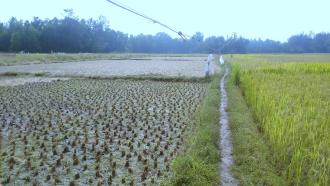Photo: Siddharth Kankaria / Research Matters
In year 2000 alone, India has incurred an estimated economic loss of US$3 to US$6 billion due to ‘ground-level ozone’, points a new study. For a country that thrives on agriculture and is faced by challenges of increasing industrialization and pollution levels, the numbers are alarming and calls for immediate action.
In a recent study funded by the Science and Engineering Research Board (SERB), Dr. S.B. Agrawal and Dr. Aditya Abha Singh from the laboratory of Air Pollution and Global Climate Change, Institute of Science, Banaras Hindu University, Varanasi, talk about the trends in varying ground-level ozone concentrations and subsequent crop loss over a period of time. The researchers have successfully established a link between the two.
Ozone in the upper levels of the atmosphere plays a significant role in filtering out the harmful ultra-violet (UV) rays from the Sun. Due to pollution and emissions of gases like nitrogen oxides; ozone is formed at ground level, which causes havoc to life forms. It creates oxidative stress in plants – an imbalance of reactive chemical species containing oxygen (like peroxides, superoxides, etc.), and the ability of the plants to detoxify this. Increase in such oxygen rich compounds triggers the antioxidant defence system, which increases the plant’s metabolic activities, reduces photosynthesis, impairs reproductive processes, accelerates aging, decreases carbon assimilation and affects the nutritional value of the grains leading to productivity losses.
The researchers compared past and present records of ground-level ozone over the Indo-Gangetic plain (IGP) - the major source for India’s rice and wheat productivity, and the respective ozone-induced losses in relative yield and nutritional quality. They observed a loss of a total of 5-11% and 3-6% relative yield loss in wheat and rice for these years. The nutritional loss was estimated based on reduced starch and total soluble sugars in seeds, decreased protein contents, reduced minerals and variation in level of various amino acids. “In the oil-yielding crops like sunflower, mustard and maize ozone leads to the increases in the amount of unsaturated fatty acids that makes it more rancid and unfit for frying purposes”, adds Dr. Agrawal.
But what leads to the formation of ground-level ozone? The study recognized that the subtropical location of India and its climatic conditions are conducive for the formation of ground-level ozone and its potential precursors like oxides of Nitrogen (NOx). This is predicted to increase rapidly, thanks to growing industrial and automobile sectors. To ensure food security, efforts that limit the emissions of oxides of Nitrogen and improve air quality standards are desperately needed.
In addition, encouraging the development of ozone resistant crops in India is another step to mitigate the effects of ozone, opine the authors. “The utilization of ozone tolerant cultivars for agriculture should be promoted after proper screening”, recommends Dr. Agrawal. “It is indeed a dream achievable in future. We need to screen and pick up the candidate genes that are responsive to ozone stress and provide tolerance to the plants. These genes may be induced or transferred in the high yield varieties to create genetically modified crop plants that would have resistance against O3”, he adds.
This study identifies the factors responsible and highlights the need to formulate policies and mitigation plans to curb emission levels and maintain air quality for our secure future. “The information provided in our review may help the policy makers to formulate policies to check the emissions of ozone precursors in India”, signs off Dr. Agrawal.






